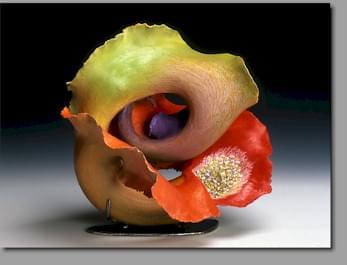|

patterns of bark or lichen or drops of rain. Edges wisp away in
lacy fine frills.
Scarpa then uses artist oils to paint
these abstract interpretations. She has worked with acrylics to
color past works, and experimented with varied ceramic glazing
techniques, but the use of oils introduces a new dimension to
her work. |
Once saturated with these layers of shading and hue, Scarpa
intertwines the separate ele-ments; a cadmium yellow frilled
basin, bursting with seeds, is
wrapped in a cloak of midnight black, encircled in crimson
folds; a coil of deepest violet nests
within a womb of pale green, while emerald, coral and garnet
waves billow out from this core. Scarpa describes these works
as paintings in clay. “Always I wanted to paint, but the square
of the canvas confined me,” she says. “Here I can break out.”
The texture of
the porcelain, the organic shapes, the luminous hues of the
oils,
 |
|
from its
boundaries, riotous, saturated Kodachrome, blooming
triumphantly.
”All summer
long, I was watching the colors of the flowers of my garden,”
says Scarpa. “Orange and yellow and
red would
come out of nowhere, and it took for my eyes to go back many
times to find a balance in this cosmos.”
The major
components of these pieces are begun on the wheel. But they soon
abandon any constraints of everyday function. Shapes move
with the free-form folds and undulations of swaying petals,
breaking waves, windblown clouds. Surfaces are meticulously
sandblasted to a liquid luster, brushed to fine filaments,
speckled with the
|
“Painting
with oils was a long process, but I could achieve transparencies
and a density that I could never find with acrylics,” says
Scarpa. "And
the oils are unique in the wonderful way they bind with the
clay.” |